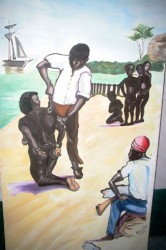An exhibition to honour the slaves who died in the 1823 revolt in then British Guiana is now open at the National Museum.
The exhibition, will run until August 31, was launched on Wednesday by the Museum of African Heritage in collaboration with the Ministry of Culture, Youth and Sport.
According to a Govern-ment Information Agency (GINA) press release, the exhibition is being held under the theme ‘Hounouring Our Heroes of 1823’ and aims to create awareness of the 1823 slave revolt, which was the first major slave rebellion in the history of the British Caribbean, where religious and christianised slaves played a role.
“During the time of this revolt many slaves lost their lives. Bachelor’s Adventure, East Coast Demerara was the village to suffer the most with over 200 slaves dying,” GINA said.
At the launch, Culture Minister Frank Anthony pointed out that on Monday, August 19, Guyana will be observing 190 years since the 1823 rebellion, which is a significant event in the nation’s history.

In his address, Anthony referenced a book, titled Hearing Slaves Speak by Jamaican professor Trevor Bernard, which talks about the lives of Guyanese slaves. It is based on actual stories told by the slaves to a magistrate, whose job was to listen to slaves’ complaints.
Anthony said he was particularly touched by the story of a pregnant slave who was given several lashes as punishment for being unable to do a task she was allotted, resulting in a miscarriage. “This is among some of the reasons that led to this revolt, the cruelty the slaves faced, their desire to be free and their desire to escape the harsh slave system,” he said.
The revolt was led by Quamina, an Africa born enslaved carpenter and the senior deacon of Bethel chapel; Jack Gladstone, a cooper on Plantation Success, Manuel from Plantation Chateau Margot, Seaton from Success, Joseph and Telemachus from Bachelor’s Adventure and Paris a boat captain of Plantation Good Hope.
As a part of the anniversary programme, a monument located opposite the Guyana Defence Force’s headquarters on Sea Wall Road was unveiled on August 5 to mark the significance of the revolt.





